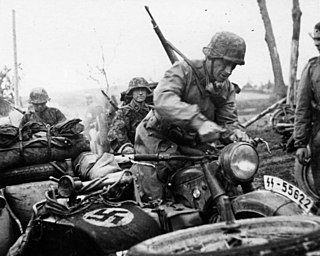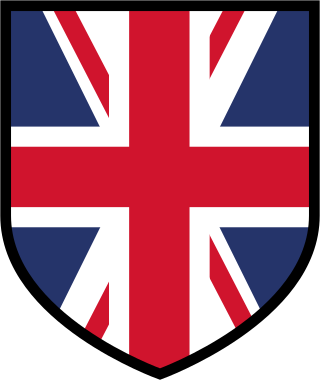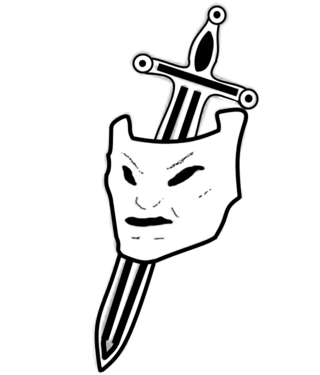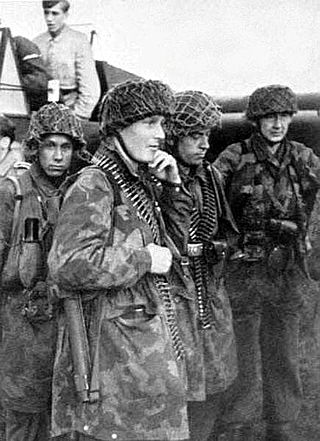Related Research Articles

The Waffen-SS was the combat branch of the Nazi Party's paramilitary Schutzstaffel (SS) organisation. Its formations included men from Nazi Germany, along with volunteers and conscripts from both German-occupied Europe and unoccupied lands. It was disbanded in May 1945.

Otto Johann Anton Skorzeny was an Austrian-born German SS-Obersturmbannführer in the Waffen-SS during World War II. During the war, he was involved in a number of operations, including the removal from power of Hungarian Regent Miklós Horthy and the Gran Sasso raid which rescued Benito Mussolini from captivity. Skorzeny led Operation Greif in which German soldiers infiltrated Allied lines wearing their enemies' uniforms. As a result, he was charged in 1947 at the Dachau Military Tribunal with breaching the 1907 Hague Convention, but was acquitted.

The British Free Corps was a unit of the Waffen-SS of Nazi Germany during World War II, made up of British and Dominion prisoners of war who had been recruited by Germany. The unit was originally known as the Legion of St George. Research by British historian Adrian Weale has identified 54 men who belonged to this unit at one time or another, some for only a few days. At no time did it reach more than 27 men in strength.

Gottlob Christian Berger was a German senior Nazi official who held the rank of SS-Obergruppenführer und General der Waffen-SS and was the chief of the SS Main Office responsible for Schutzstaffel (SS) recruiting during World War II. At the post-war Nuremberg trials, the Waffen-SS – within which Berger was a senior officer – was declared to be a criminal organisation due to its major involvement in war crimes and crimes against humanity. Berger was convicted as a war criminal and spent six and a half years in prison.

The Brandenburgers were members of Nazi Germany's Wehrmacht special forces unit during World War II.

The Walloon Legion was a unit of the German Army (Wehrmacht) and later of the Waffen-SS recruited among French-speaking collaborationists in German-occupied Belgium during World War II. It was formed in the aftermath of the German invasion of the Soviet Union and fought on the Eastern Front alongside similar formations from other parts of German-occupied Western Europe.

Frank Ryan was an Irish politician, journalist and soldier. He first came to prominence as an Irish republican activist at University College Dublin and fought for the Irish Republican Army during the Irish Civil War. Ryan fell under the influence of Peadar O'Donnell, an advocate of socialism within Irish republicanism, which resulted in him breaking with the IRA and becoming involved with founding a new political organisation, the Republican Congress, and editing its associated newspaper, An Phoblacht.
Sidney Robey Leibbrandt was a South African Olympian, who during World War II acted as an Abwehr agent for the Third Reich against the British Empire in South Africa. In 1943, he was convicted of high treason by a South African court and imprisoned for 5 years.
Operation Seagull I was an Abwehr II sanctioned mission devised in May 1942. The plan was the brainchild of Kurt Haller and an expert from Abwehr I-Wi (economic). The plan envisioned the use of an Abwehr agent to sabotage the North Scottish power station at Fort William.
Operation Seagull II was an Abwehr II. sanctioned mission planned in June 1942 as a refinement of Operation Seagull I. The plan envisioned in Seagull II was to use an Irish Abwehr agent ("V-Manner"), who would parachute into the area of south-east of Ballycastle in Northern Ireland, recruit a sabotage team from any willing IRA personnel in the area, and attack important "targets of opportunity" in the immediate vicinity. Both operations were to be controlled by radio and with each sabotage team in Ireland and Scotland liaising with each other via radio contact.
Operation Osprey was a plan conceived by the German Foreign Ministry and Abwehr II. mid-1942. The plan was an enlargement of Operation Whale. Planning took place in the context of American troops landing in Northern Ireland 26 January 1942, and Hitler's immediate fears surrounding this.

The "Irish Brigade" was an attempt by Sir Roger Casement to form an Irish nationalist military unit during World War I among Irishmen who had served in the British Army and had become prisoners of war (POWs) in Germany. Casement sought to send a well-equipped and well-organised Irish unit to Ireland, to fight against Britain, in the aim of achieving independence for Ireland. Such an action was to be concurrent with the ongoing war between Britain and Germany, thereby providing indirect aid to the German cause, without the ex-POWs fighting in the Imperial Germany Army itself.
Friesack Camp or Camp Friesack was a special World War II prisoner of war camp where a group of Irishmen serving in the British Army volunteered for recruitment and selection by Abwehr II and the German Army. The camp was designated Stalag XX-A (301) and located in the Friesack area, Brandenburg region. The training and selection by Abwehr II and the German Army occurred during the period 1940–1943.
John Codd was an Irish-born British Army corporal during World War II, who went on to serve in the German Intelligence service (Abwehr) and the Sicherheitsdienst, the foreign intelligence arm of the SS.
Operation Innkeeper was an aborted plan devised in Autumn 1941 to send two Irish Abwehr agents to London on a sabotage mission.

The 500th SS-Parachute Battalion was the airborne unit of the Waffen-SS. The idea to form a paratrooper unit within the Waffen-SS allegedly came directly from Reichsführer-SS Heinrich Himmler.
The Bezen Perrot, officially the Breton SS Armed Formation was a small collaborationist unit established by Breton nationalists in German-occupied France during World War II. It was made up of personnel from Lu Brezhon, a Breton nationalist militia, under the leadership of Célestin Lainé.
SS-Jäger-Bataillon 502 was a special forces unit of Nazi Germany's SS from 1943-1944.
Sonderlehrgang z.b.V. "Oranienburg" was a commando and special forces unit of Nazi Germany's SS. It was assembled in early 1942 on the order of SS-Obergruppenführer Hans Jüttner as a rival to the Heer's Brandenburg Regiment.

George Frank McLardy MPS was a member of the British Union of Fascists, a British Nazi collaborator and an Unterscharführer in the Waffen-SS British Free Corps during the Second World War.
References
- ↑ "Jig Heil! The free-born Irish who saluted the Führer". Independent.ie. 13 February 2010. Retrieved 12 March 2024.
- ↑ THE STORY OF ROTTENFUHRER JAMES BRADY WAFFEN SS.